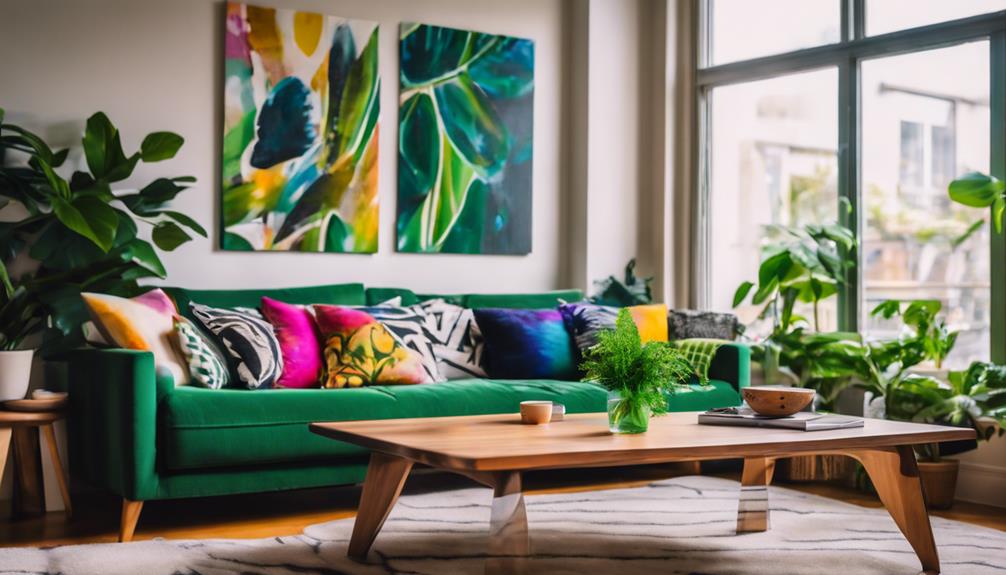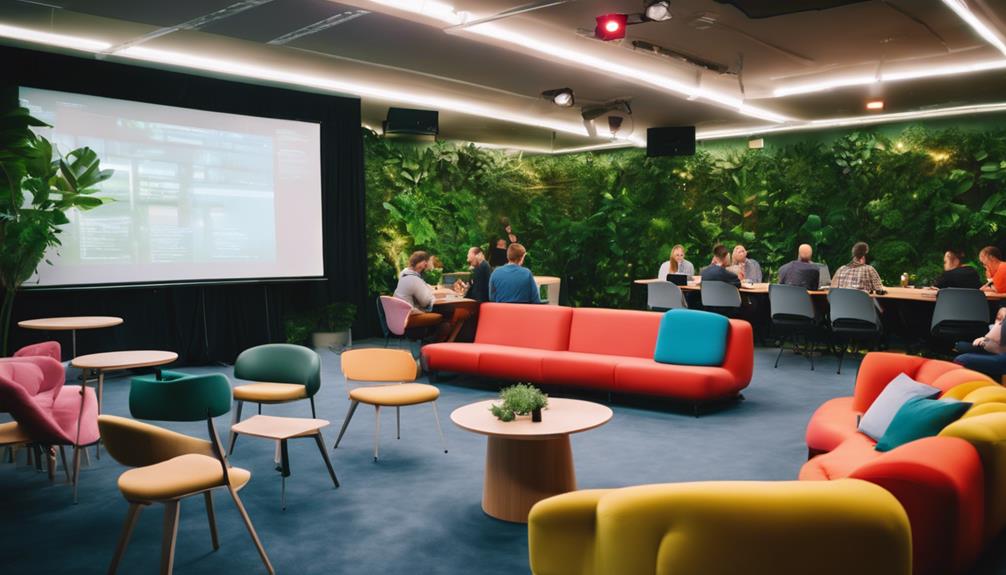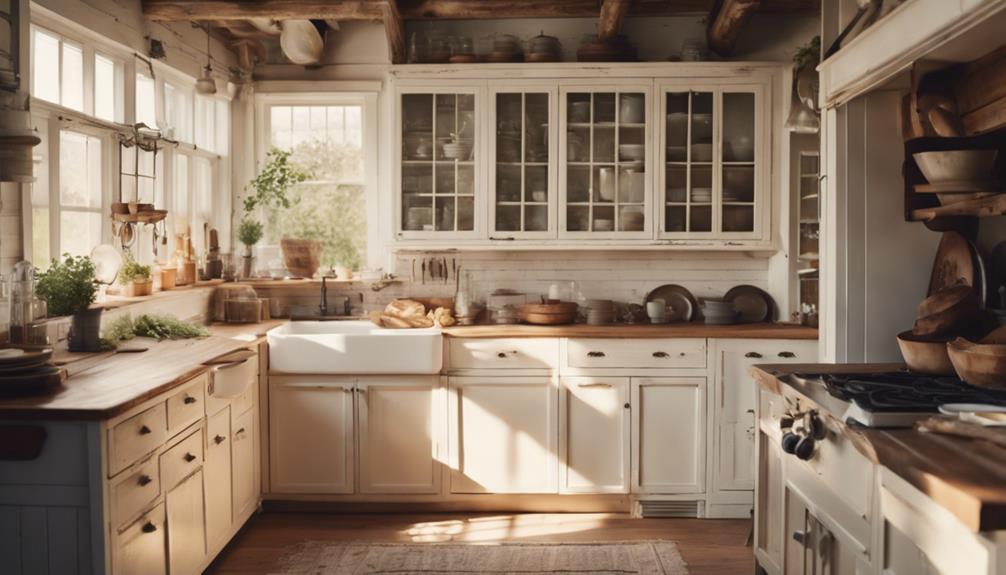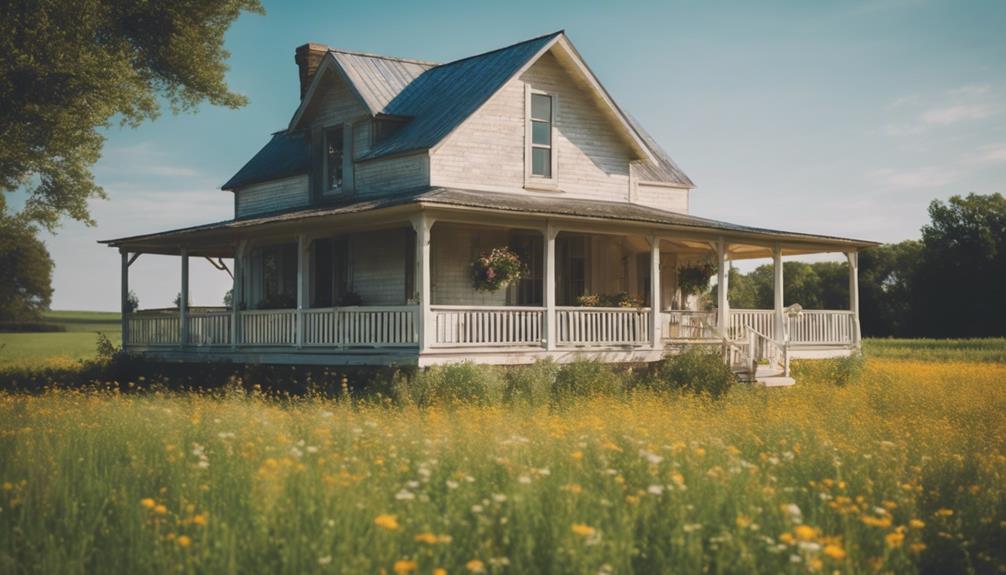In just two weeks, you can infuse your home with Scandinavian style as a color enthusiast by combining vibrant accents with minimalist design. Begin by selecting a neutral palette of whites and greys, then inject splashes of color through textiles and accessories. Invest in versatile furniture like sleek armchairs and coffee tables crafted from light-toned woods. Integrate warm lighting with soft glow lamps and pendant lights to establish a cozy atmosphere. Lastly, bring in natural elements such as ceramic vases and handwoven wall hangings that embody simplicity. By following these suggestions, you will soon appreciate the allure of Scandinavian design in your living space.
Key Elements
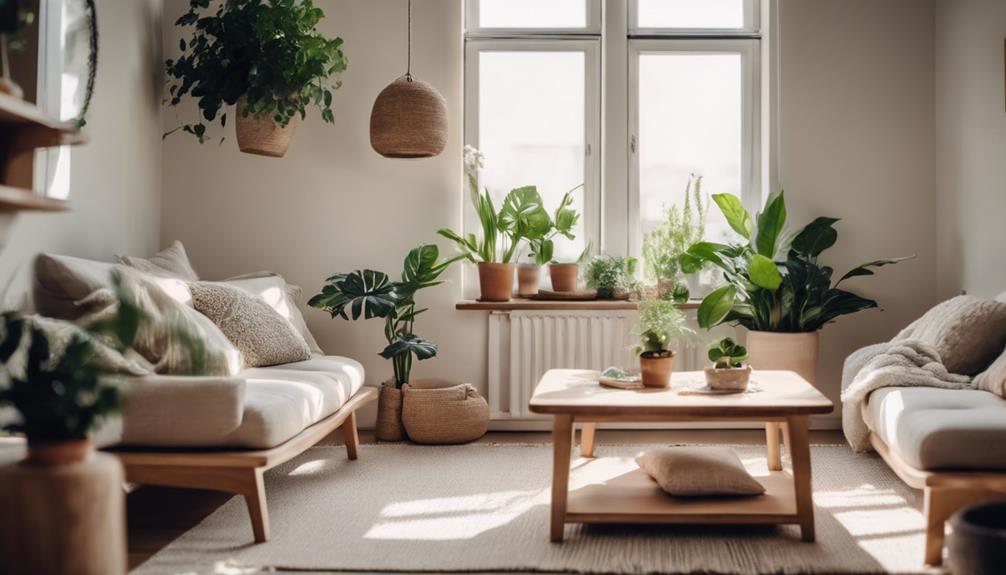
To capture the essence of Scandinavian style, you'll want to focus on three key elements: color scheme, materials, and textures.
A neutral palette, natural materials, and inviting textures work together to create that cozy yet minimalist vibe.
Let's explore how each of these components contributes to a harmonious and functional space.
Color Scheme
A carefully chosen neutral color palette, featuring whites, greys, and muted pastels, lays the groundwork for the calming ambiance that defines Scandinavian style. This foundation creates a serene environment, allowing you to breathe and relax.
To inject personality and warmth into your space, consider incorporating vibrant accent colors like rust orange or sage green. These hues maintain the overall Scandinavian aesthetic while providing a touch of individuality.
You can also blend earthy tones inspired by natural elements, such as olive green and soft browns, with your neutral shades. This combination adds depth and comfort to your decor.
Embracing cooler tones, like light blues, can serve as near-neutrals, creating a tranquil backdrop that allows warmer accent colors to pop.
To keep your space fresh and trendy, rotate seasonal accent colors in decor items, such as cushions or artwork. This practice aligns perfectly with the Scandinavian emphasis on simplicity and functionality while ensuring your home reflects contemporary styles.
Materials
Natural materials like light-toned woods, textiles, and leather are essential for achieving the warmth and coziness characteristic of Scandinavian style.
You'll want to incorporate woods such as birch, beech, and pine, which not only enhance your space but also create a welcoming environment. Textiles are equally important; think about using cotton, wool, and leather to add comfort and aesthetic appeal. These materials help establish that serene atmosphere central to Scandinavian design.
When selecting colors, opt for neutral palettes like whites, greys, and muted pastels. These hues maximize natural light and contribute to a calm, uncluttered feel.
Accessories like sheepskin rugs or faux fur throws can elevate the coziness factor while keeping in line with minimalist principles.
Don't forget multifunctional furniture, such as storage ottomans or convertible sofas. These pieces reflect the practicality of Scandinavian style and help maintain an airy, decluttered space.
Textures
Textures considerably enrich Scandinavian design, adding warmth and depth that make minimalist spaces feel inviting and cozy. By incorporating various textures, you can enhance the overall atmosphere of your home while keeping to neutral colors. Think about using soft wool throws, smooth leather accents, and natural wood elements. Each material contributes to a tactile experience that complements the clean and functional aesthetic typical of Scandinavian style.
Layering textiles is also essential. Knitted blankets, plush rugs, and textured pillows create a comfortable and inviting environment, embodying the 'hygge' concept that Scandinavian homes are known for. Don't overlook the use of natural materials like jute and cotton; they provide an organic touch that fosters a connection with nature, a fundamental aspect of this design philosophy.
Additionally, emphasizing textures through decorative elements like woven baskets and handcrafted pottery reinforces the simplicity and functionality of your space. By thoughtfully selecting these elements, you'll not only achieve warmth and comfort but also create a harmonious balance that makes your home uniquely inviting.
Embrace textures to truly elevate your Scandinavian-inspired space!
Essential Fixtures and Furniture
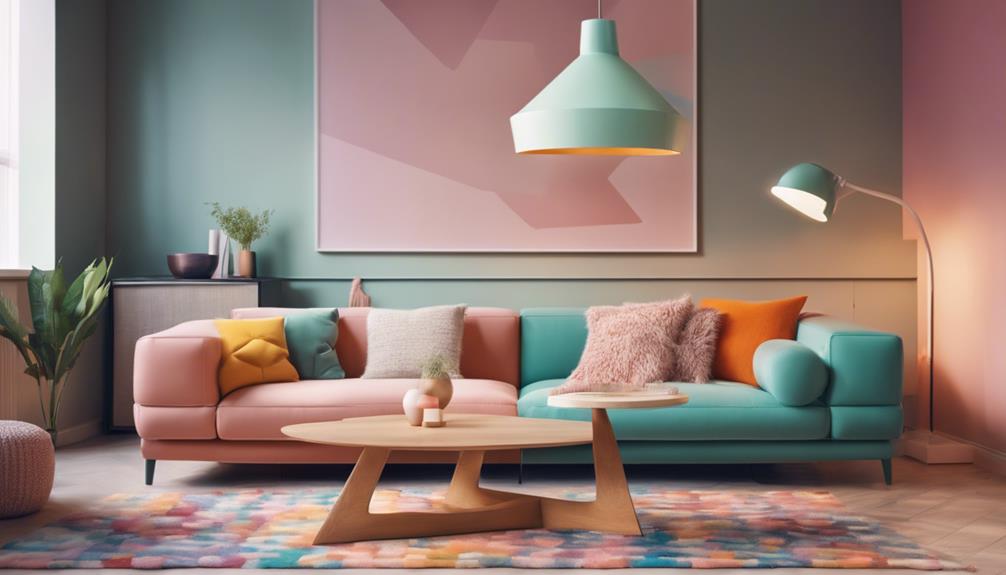
When it comes to essential fixtures and furniture in Scandinavian style, you'll want to focus on key pieces that embody simplicity and functionality.
A Scandinavian-style coffee table, armchair, and side table can transform your space while keeping it airy and inviting.
Let's explore how these elements can enhance your home's aesthetic and comfort.
Scandinavian-Style Coffee Table
Scandinavian-style coffee tables bring together clean lines and functional design, making them essential fixtures for any modern living space. These tables often feature a minimalistic aesthetic, crafted from light-toned woods like oak or birch, which enhances the airiness of your room. You'll appreciate how their neutral colors allow them to blend seamlessly with various decor styles, contributing to a calm and serene atmosphere.
Functionality is key in Scandinavian design. Many coffee tables come equipped with built-in storage or extendable surfaces, making them perfect for compact areas where versatility is vital. This practicality doesn't sacrifice style; the simplicity of these tables encourages you to showcase decorative elements like books, plants, or unique art pieces, adding personality without overwhelming your space.
Sustainability also plays a significant role in the design of Scandinavian coffee tables. Manufacturers prioritize eco-friendly materials and responsible production practices, reflecting a broader commitment to environmental consciousness. By choosing a Scandinavian-style coffee table, you're not just enhancing your living space; you're also supporting sustainable design, making a positive impact on the environment while enjoying timeless elegance.
Scandinavian-Style Armchair
You'll find that a Scandinavian armchair perfectly balances sleek design with exceptional comfort, making it an essential addition to any modern living space.
These armchairs are characterized by clean lines and a minimalistic design that embodies the understated elegance typical of Scandinavian homes. Crafted from natural materials like light-toned woods such as birch or oak, they create a bright and inviting atmosphere, enhancing your connection to nature.
Upholstered in neutral colours or muted tones, these chairs not only amplify the simplicity of your decor but also provide warmth and texture through soft textiles like wool or cotton.
This combination of aesthetics and functionality guarantees that your armchair is versatile, often featuring removable covers or modular components that adapt to your living environment.
Scandinavian-Style Side Table
A well-chosen side table can enhance the comfort of your Scandinavian-style armchair while maintaining the room's clean, minimalist aesthetic. A Scandinavian-style side table typically features clean lines and a sleek silhouette, often crafted from light-toned woods like birch, oak, or pine. These natural wood finishes not only add warmth but also embody the principles of sustainability that are central to Nordic design.
When selecting your side table, look for options in neutral shades like white or grey to guarantee it seamlessly blends with your existing decor. Many designs incorporate functional features such as open shelving or drawers, adding practicality without compromising the table's streamlined look.
Popular elements like tapered legs and geometric shapes contribute to the airy feel typical of Scandinavian interiors, making the side table a versatile accent piece. By choosing a side table that emphasizes eco-friendly materials and production methods, you'll further align with the values of conscious consumption.
This thoughtful approach not only enriches your space but also enhances your commitment to sustainability, making your home both stylish and responsible.
Lighting Ideas
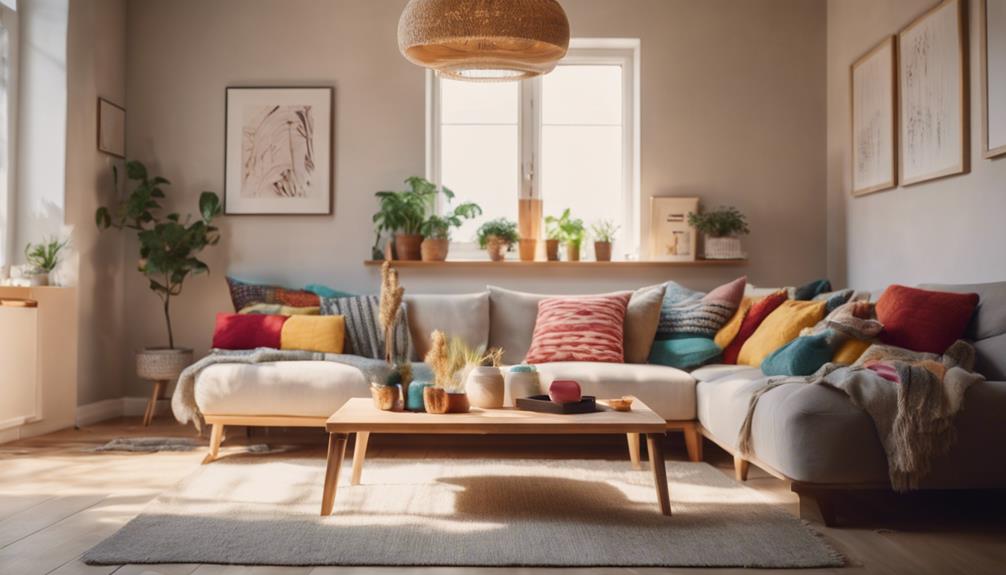
When it comes to lighting in Scandinavian design, you'll want to focus on creating a warm and inviting atmosphere.
Consider incorporating pendant lights with wood accents, soft glow table lamps, and wall-mounted sconces that add warmth to your space.
Don't forget about candlelit lanterns for that extra touch of ambiance, especially during those cozy evenings.
Pendant Lights With Wood Accents
Pendant lights with wood accents bring warmth and texture to your space, perfectly embodying the essence of Scandinavian design. By incorporating natural materials like light-toned woods, such as birch or oak, these fixtures promote a sense of lightness and airiness in your interiors. Their minimalist shapes complement the clean lines characteristic of the style, ensuring they blend seamlessly into your decor.
When you choose pendant lights with adjustable heights, you gain versatility in design. This feature allows you to customize the lighting based on the function of the space, aligning with the key principles of Scandinavian functionality. Whether you're illuminating a dining area or creating a cozy nook, these lights can be tailored to fit your needs.
Additionally, incorporating pendant lights with wood accents can create a cozy atmosphere, supporting the concept of 'hygge' central to Scandinavian living. This makes your spaces feel inviting and warm, perfect for gatherings or quiet evenings.
Embrace these elements, and you'll find that pendant lights with wood accents not only enhance your decor but also enrich the overall feel of your home.
Soft Glow Table Lamps
Soft glow table lamps enhance the inviting ambiance of your home, perfectly complementing the warmth created by pendant lights with wood accents. In Scandinavian design, these lamps are essential for achieving that cozy atmosphere, or hygge, you crave. They provide warm, inviting light that works beautifully with neutral color palettes, creating a harmonious environment.
You'll find that many soft glow table lamps feature minimalist designs with clean lines and natural materials like wood and metal. This simplicity aligns with the principles of functionality inherent in Scandinavian aesthetics. Choosing lamps with dimmable features allows you to adjust the ambiance to suit various moods and settings, whether you're hosting friends or enjoying a quiet evening.
Moreover, opting for designs from Scandinavian brands often means embracing environmental consciousness. Many of these lamps are crafted from eco-friendly materials and use energy-efficient bulbs, which help minimize your environmental impact. By incorporating soft glow table lamps into your space, you not only enhance your home's style but also embrace a more sustainable living approach.
Wall-Mounted Sconces With Warmth
Wall-mounted sconces illuminate your space with warmth, effortlessly enhancing the cozy vibe that defines Scandinavian design. When you choose sconces with warm light bulbs, you create an inviting atmosphere that complements the neutral color palettes typical of Scandinavian decor.
Opt for sconces crafted from natural materials like wood or metal, as these elements align with the Scandinavian emphasis on sustainability and organic aesthetics. Their clean lines and minimalistic designs reflect the simplicity and functionality that characterize this style.
To maximize the impact of your sconces, position them at varying heights; this not only adds visual interest but also enhances the use of natural light during the day. Many Scandinavian-inspired sconces offer adjustable designs, allowing you to direct light exactly where it's needed, making your spaces both inviting and practical.
Candlelit Lanterns for Ambiance
Candlelit lanterns beautifully complement wall-mounted sconces, adding an extra layer of warmth and ambiance to your Scandinavian-inspired space. These lanterns enhance the cozy vibe typical of Scandinavian design, especially during the long winter months when natural light fades.
When choosing your candlelit lanterns, opt for those made from natural materials like wood or metal. This choice resonates with the Scandinavian aesthetic, emphasizing organic textures and simplicity. For a safe and sustainable option, consider using LED candles inside the lanterns. They'll still provide that inviting warm glow characteristic of traditional candlelight while eliminating the worry of open flames.
Strategically placing these lanterns around your living spaces fosters the essence of 'hygge'—the Danish concept of comfort and coziness. Look for lanterns with glass panels to maximize light diffusion while maintaining a minimalist appearance. This aligns perfectly with the clean lines and uncluttered design principles that define Scandinavian decor.
Incorporate candlelit lanterns into your home, and you'll instantly elevate the ambiance, creating a warm and inviting atmosphere that feels just right.
Decorative Elements

To truly capture Scandinavian style, you'll want to incorporate decorative elements that reflect simplicity and nature.
A handwoven wool wall hanging can add texture, while a ceramic vase filled with greenery brings life into your space.
Don't forget a vintage Scandinavian ceramic bowl to serve as a functional yet stylish accent piece.
Handwoven Wool Wall Hanging
Handwoven wool wall hangings bring a touch of warmth and texture to your Scandinavian-inspired space, enhancing its cozy atmosphere with natural materials. These pieces often feature neutral or earthy tones that perfectly complement the typical Scandinavian color palette, while still allowing for vibrant accents to shine through.
When you incorporate a handwoven wall hanging, you showcase an appreciation for quality craftsmanship, embodying the Scandinavian ethos of sustainability. Many of these hangings are made from locally sourced or eco-friendly wool, reflecting a commitment to both the environment and artisanal traditions.
Additionally, a handwoven wool wall hanging can serve as a striking focal point in your minimalist decor, emphasizing simplicity and functionality. As modern Scandinavian designers embrace traditional weaving techniques, these textiles are experiencing a resurgence, connecting contemporary design with cultural heritage.
Ceramic Vase With Greenery
A ceramic vase with greenery adds a fresh, organic touch to your Scandinavian decor, seamlessly blending nature with minimalist design. The beauty of this combination lies in the ceramic vase's clean lines and neutral tones, which enhance the serene atmosphere typical of Scandinavian design.
When you incorporate greenery, like hardy succulents or ferns, you not only bring life into your space but also align with the trend of connecting indoors with the outdoors. These plants thrive in environments with abundant natural light, making them perfect for Scandinavian homes.
The ceramic material contributes warmth and texture, transforming the vase into both a functional and artistic element. Placing a ceramic vase with greenery in your living space creates a focal point that draws attention to nature's beauty while maintaining simplicity.
Whether you choose to display it on a coffee table or a windowsill, this decorative element reinforces the inviting and tranquil vibe characteristic of Scandinavian decor. Embrace this stylish choice, and watch how it elevates your space, making it feel more vibrant and connected to the natural world.
Vintage Scandinavian Ceramic Bowl
Vintage Scandinavian ceramic bowls bring a unique blend of history and style to your decor, infusing your space with earthy tones and minimalist designs. These bowls typically showcase clean lines and natural glazes, reflecting the region's deep connection to nature. By incorporating them into your home, you embrace the core principles of Scandinavian design, which prioritize simplicity and functionality.
Renowned ceramicists like Hans Christian Andersen and Rörstrand crafted many of these vintage pieces, ensuring high-quality craftsmanship and unique styles. When you collect vintage ceramic bowls, you're making a sustainable choice that aligns with the ethos of recycling and repurposing inherent in Scandinavian culture.
Displaying these bowls as decorative elements not only enhances your aesthetic but also adds a touch of authenticity and history to your Scandinavian-inspired interiors. Whether you place them on a shelf, use them as centerpieces, or simply admire their beauty, vintage Scandinavian ceramic bowls serve as a demonstration of timeless design.
Flooring

When it comes to flooring in a Scandinavian-inspired space, you'll want to choose materials that reflect simplicity and warmth.
Light oak hardwood or reclaimed pine plank flooring can enhance the natural light and create a cozy atmosphere.
Pairing these with soft textured area rugs not only adds comfort but also complements the minimalist aesthetic beautifully.
Light Oak Hardwood Flooring
Light oak hardwood flooring brings warmth and brightness to Scandinavian interiors, effortlessly enhancing the natural light in your home. Its light hues create a bright and airy atmosphere, perfectly aligning with the principles of Scandinavian design. By choosing light oak, you embrace a minimalist approach that prioritizes simplicity while promoting a sense of tranquility.
Not only does light oak add beauty, but it's also highly durable and resistant to wear, making it ideal for high-traffic areas. You won't have to worry about sacrificing style for functionality. The natural grain patterns and textures of light oak bring an organic feel to your space, connecting indoor environments with the outdoors.
This versatile flooring can seamlessly complement neutral color palettes, allowing you to incorporate vibrant accent colors without overwhelming your decor. Whether you're updating for the seasons or looking for a timeless look, light oak provides a solid foundation for your design choices.
Plus, installing this sought-after feature can increase your home's value, appealing to future buyers who appreciate the elegance of Scandinavian styling. With light oak hardwood flooring, you're not just enhancing your space; you're embracing a lifestyle.
Reclaimed Pine Plank Flooring
Reclaimed pine plank flooring is an excellent choice for enhancing the warmth and character of your Scandinavian-inspired home. This flooring option not only brings a rustic charm but also aligns beautifully with the minimalist ethos of Scandinavian design. The light tones of reclaimed pine brighten your space, maximizing natural light and creating a serene atmosphere.
One of the standout features of reclaimed pine is its unique knots and grain patterns, which add depth and personality to your interiors. This eco-friendly choice is sourced from old buildings and furniture, promoting sustainable practices while reducing waste. By opting for reclaimed pine, you're contributing positively to the environment.
Additionally, installing reclaimed pine plank flooring can improve your indoor air quality. Unlike synthetic flooring options that often emit harmful VOCs, reclaimed pine is a natural material that keeps your living space healthier. The warmth it provides makes your home inviting, ensuring that every room feels cozy and welcoming.
Soft Textured Area Rugs
Soft textured area rugs bring a cozy touch to your Scandinavian-inspired home, making neutral spaces feel warm and inviting. These rugs enhance comfort in your minimalist decor, preventing the space from feeling cold and sterile. Opt for materials like wool, jute, or cotton that align with the principles of sustainability and eco-friendliness.
When selecting area rugs, look for soft pastels or muted tones that complement the neutral colors dominating your aesthetic. Simple patterns can seamlessly blend into your design, allowing the rugs to act as a subtle yet effective statement piece. Remember that size matters; choose rugs large enough to anchor your furniture, creating a cohesive space that embodies Scandinavian functionality.
Textured options, such as sheepskin or faux fur, introduce layers of softness and tactile contrast. These additions not only enhance the visual appeal of your home but also invite you to experience a comforting sensation underfoot.
How Can I Embrace Scandinavian Style in my Home Without Clutter?
Embracing Scandinavian style in your home without clutter is possible with the use of scandinavian open shelving styling techniques. Utilize simple, functional shelves to display decor and keep items organized. Focus on clean lines, neutral colors, and natural materials to create a minimalist yet cozy aesthetic.
Can Embracing Scandinavian Style Help in Reducing Clutter in Home Decor?
Embracing Scandinavian open shelving styling techniques can be a game-changer in reducing clutter in home decor. By incorporating minimalistic design, natural elements, and functional storage solutions, you can create a clean and organized living space that is both stylish and clutter-free.
Conclusion
In just two weeks, you've transformed your space into a Scandinavian haven while honoring your love for color.
By focusing on key elements, essential fixtures, and thoughtful lighting, you've created a warm, inviting atmosphere.
Incorporating decorative elements adds personality without compromising simplicity.
Finally, the right flooring ties everything together, enhancing the overall aesthetic.
Embrace this fresh style and enjoy the perfect blend of minimalism and vibrant touches that reflect your unique taste!
